A Topography of Becoming
Ricardo J. Reyes, PhD
Hee Sook Kim, artist and educator, once again relies on her artmaking to help sort, think through, and address the social condition in which many of us found ourselves in the last two years. In this survey, Hee Sook Kim: Surfacing, Kim presents three recent bodies of work that are deeply rooted in her daily experience as an Asian American woman artist, revealing how this complex identity surfaces in her paintings. Kim observes her immediate surroundings, mediates them through reflection and negation, and then both unifies and combines the experience of these elements into a unique visual expression. What the viewer witnesses are canvases rich with gestural marks, decorative patterning, and intentional use of color, further embellished with fabric, ribbons, and gems.
The notion of surfacing is employed as a way of describing how Kim synthesizes her foundation- al concepts with her material considerations. The onlooker is attracted by the delightful colors and sparkling decorations worked onto the surface of the canvas. The artist expertly combines facture, impasto, and decoration to create a field full of topographical features that keep the eye moving through the pictorial plane. These features begin to communicate the underlying themes that Kim infuses in her work. What surfaces are her experiences as a woman becoming an artist and an immigrant becoming an American, while in search of an artistic practice that promotes healing and joy. The longer the viewer spends with each work, the more these themes reveal themselves through the dialogue between the formal/technical elements and the various narrative ploys.
Two recent major events in the United States rattled commonplace understandings and experiences of sociability: the COVID-19 pandemic and the global protests calling for racial justice. The pandemic forced us to isolate ourselves at home due to lockdowns or practice social distancing when in public. The Summer of Racial Reckoning, as NPR called it, precipitated by the killings of George Floyd, Breonna Taylor, Ahmaud Arbery, and many others before them by police officers or armed white assailants, forced us to confront the racism embedded in our institutions. Overnight, many Americans—white Americans especially—faced a fractured social foundation that had previously been obscured by the distractions of capitalism. Within this historical context, many artists made work to deal with these issues and the emotional, mental, and physical states in which they found themselves.
Woman as Artist
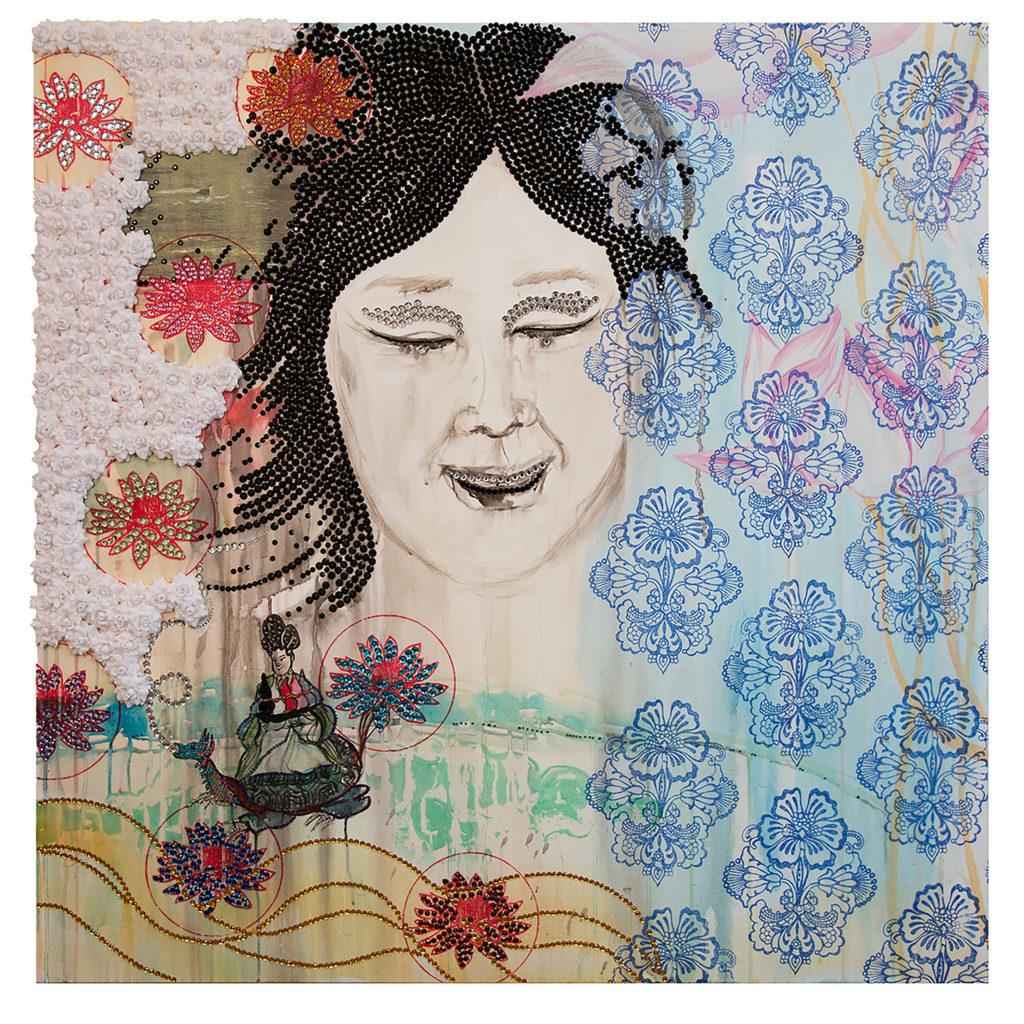
Nirvana 1, 2019
Oil, acrylic, rhinestones, silk flower on canvas 48 x 48 in.
Kim was also affected by the changing world around her. By honing a unique artistic practice over the last forty years, she has been able to pivot and refocus her energies on actions and thoughts that were productive and healing. Her process of seeing-thinking-becoming engages her to see and be in the moment, to reflect on her emotional or mental state at that moment, and to be moved or become a new person at that moment. She can synthesize her surroundings with her ideas and feelings into something new, however grand or nuanced.
As an art student at the Seoul National University, Kim experienced the limitations that the patriarchal and male-dominated Korean society placed on her. She recounted harsh criticism and discouragement from pursuing a career as an artist. It is in this context that Kim, in her rebellion and resistance, found her process: she saw the world against her, thought and felt differently about it, and became an artist despite these obstacles. She nurtured her female nature and cultivated an identity that celebrated her womanhood. She writes, “When I started my career
as an artist, I used the dream of a butterfly found in the writings of Chuang Tzu, the Taoist philosopher, as a symbol of female identity, of being a woman in the world.”
The theme of being a woman in the world surfaces in Kim’s Nirvana series (2019). Through the artist’s signature use of paint, pattern, beads, gems, and fabric, the twenty pictorial scenes narrate her experiences. Viewed together, they act as miniatures in a Buddhist Mahayana, showing episodes in a bodhisattva’s life of service and compassion, intermingled with images
of flora and fauna. Nirvana 1 (2019, oil, acrylic, rhinestone, silk flower on canvas, 48” x 48”) depicts a smiling face with hair made of strings of shiny black beads blowing in the breeze. With the figure’s eyes closed, the outline of a lotus petal appears, borrowing a stylized shape from Buddhist paintings. The top left corner is adorned with a mass of white flowers that looks like a cloud raining bejeweled lotus blossom bubbles. Under the cloud, a female figure sits atop a turtle aspirating spirals of rhinestones. Male monks are often depicted sitting on turtles as a symbol
of life’s enduring meaning. Kim replaces the standard male figure with a female, Guanyin, the Goddess of Compassion, one of the most beloved deities of the Buddhist pantheon. On the right, a painted decorative floral pattern covers the foreground like a sheer curtain, veiling the landscape in the background. The repeated flowers are peonies, a symbol of happiness. Overall, the painting expresses Kim’s long and slow journey to happiness or peace with her femininity and female identity.
Asian American Patriotism
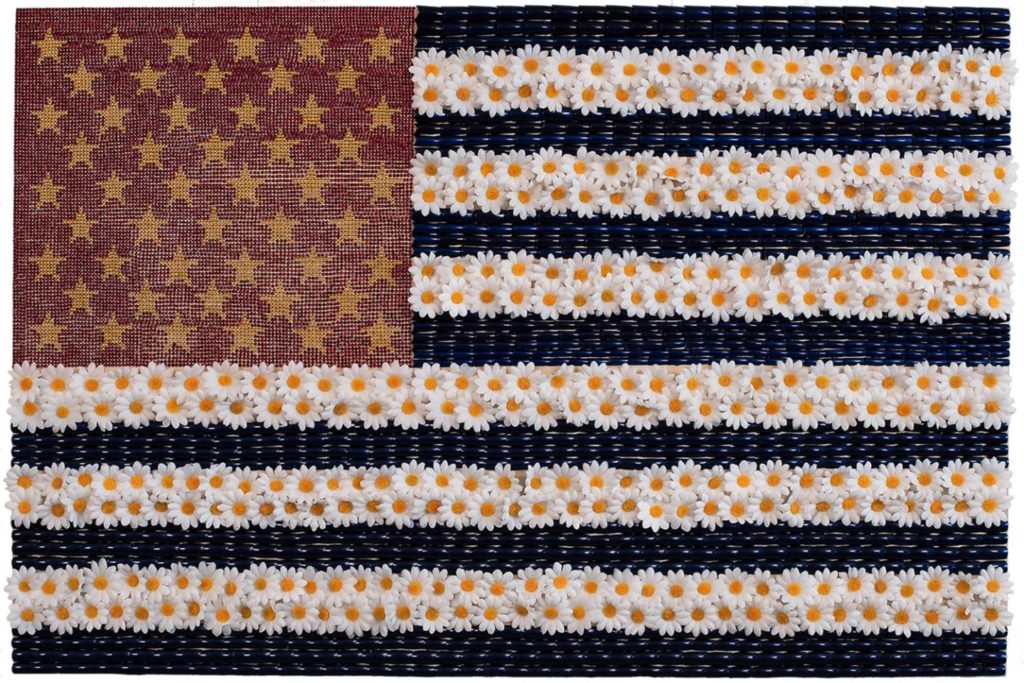
My American Flag 2, 2018
Acrylic, rhinestones, silk flowers, fake nails on wood panel
24 x 36 in.
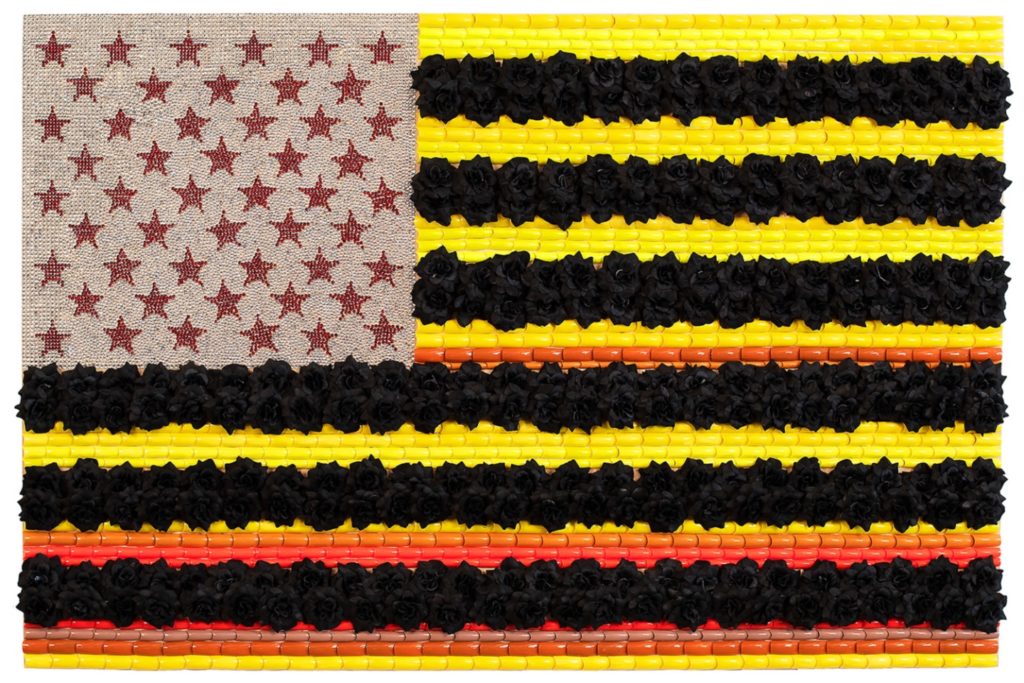
My American Flag 3, 2018
Acrylic, rhinestones, silk flowers, fake nails on wood panel
24 x 36 in.
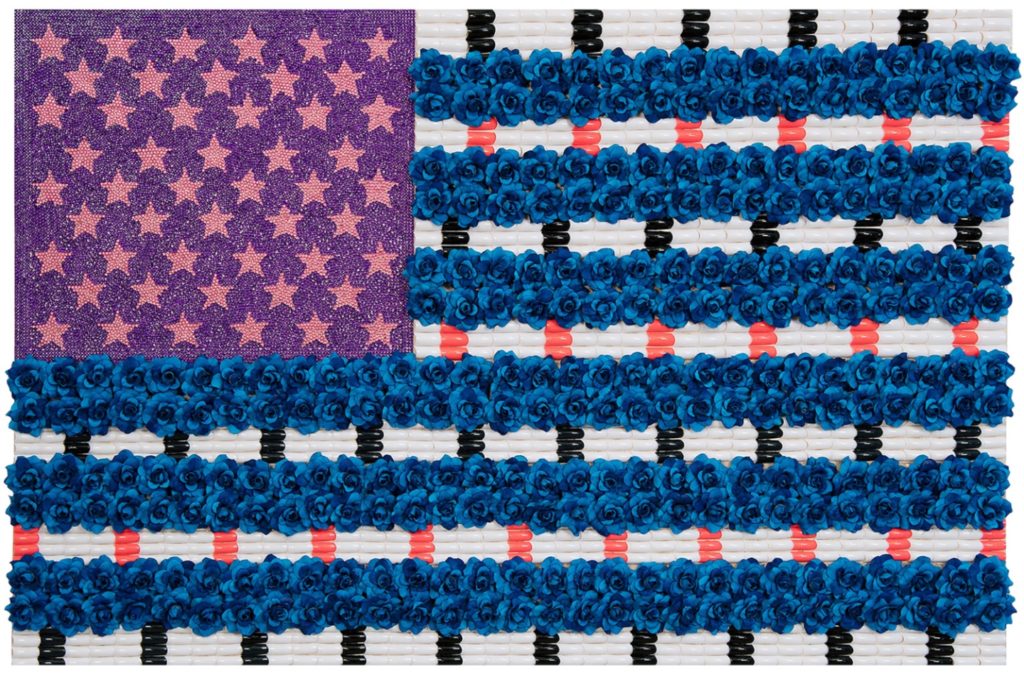
My American Flag 5, 2018–19
Acrylic, rhinestones, silk flowers, fake nails on wood panel
24 x 36 in.

My American Flag 6, 2018–19
Acrylic, rhinestones, silk flowers, fake nails on wood panel
24 x 36 in.
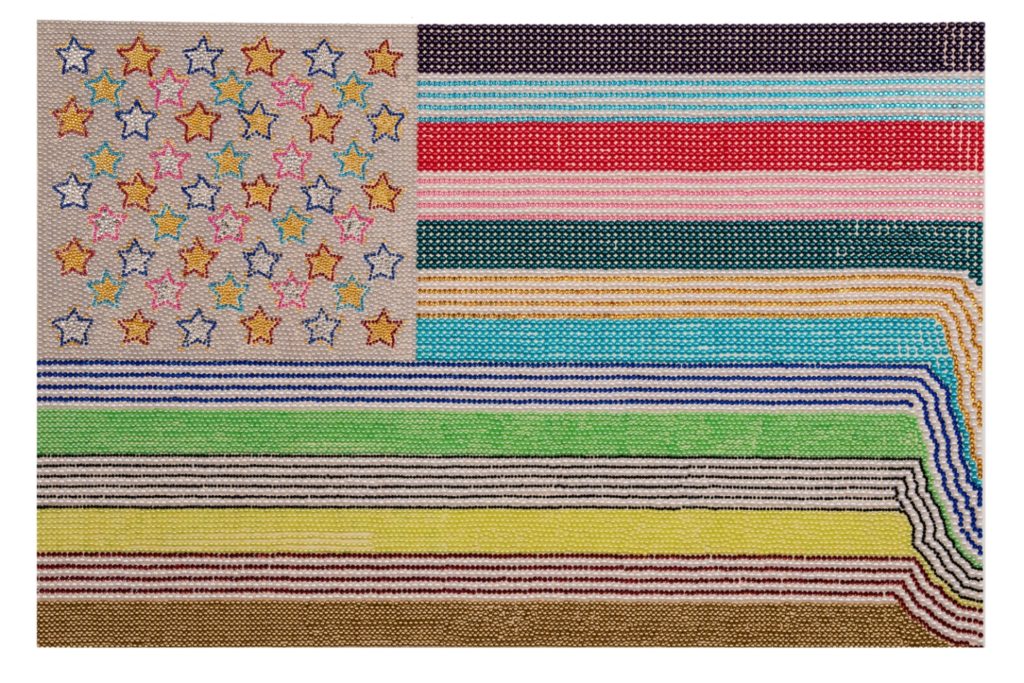
My American Flag 15, 2020–22
Acrylic, rhinestones, silk flowers, fake nails on wood panel
24 x 36 in.
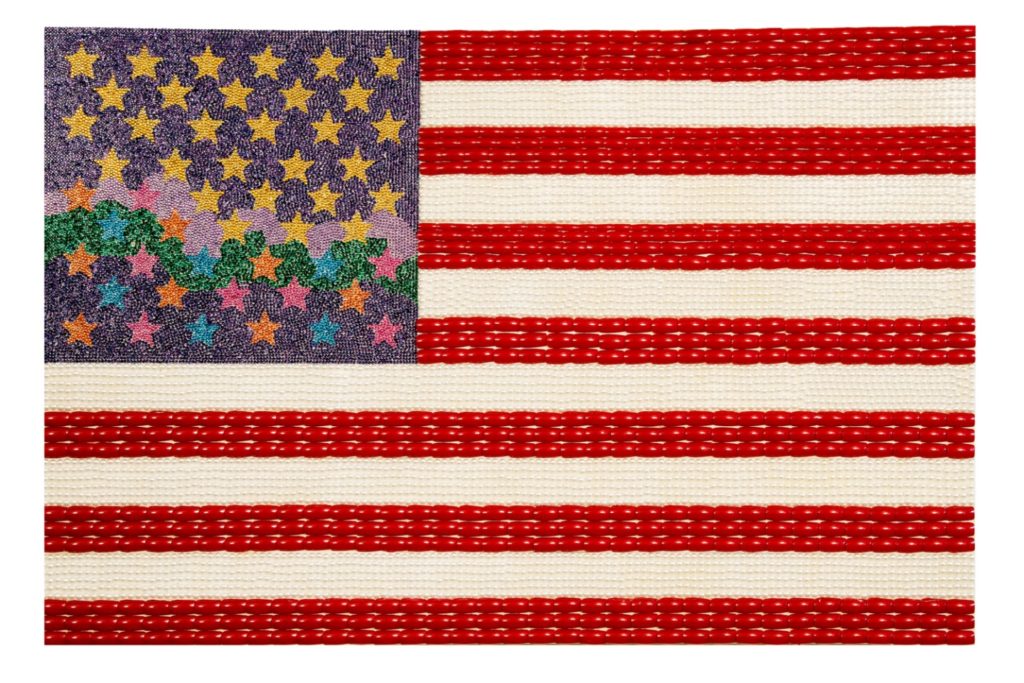
My American Flag 21, 2020–22
Acrylic, rhinestones, silk flowers, fake nails on wood panel
24 x 36 in.
The use of beads, rhinestones, ribbons, silk flowers, and floral patterns is a strategy that Kim uses to put what she calls a “feminine veil” on her canvases. The veil is not only an intentional act of resistance against male-dominated Korean culture, but also an assertion of her female identity.
In her My American Flag (2018–21) series, Kim expands her material vocabulary and introduces fake fingernails. Her immigration to the United States thirty years ago was in some ways an escape from Korean patriarchy, but it also added another layer of challenges. After spending years combating sexism in Korea, Kim was faced with battling racism as a Korean immigrant
to the US. My American Flag addresses the intersection of her identity as a woman and as an Asian American. The twelve works in this series begin with the US flag, borrowing its form and composition and retaining its iconic stars and stripes. However, the flags are made of fake fingernails, rhinestones, and silk flowers mounted on board.
Kim has been dealing with the politics of racialization in the US since her arrival, but it wasn’t until 2016, when she reached parity between the number of years she lived in Korea and in the US, that she began to contemplate her hybridized status as an immigrant. Coincidentally, it was also the year that Donald Trump was elected to office on an anti-immigrant platform. Kim decided to confront this issue through the use and appropriation of the American flag. Anti-im- migration sentiment started to become institutionalized as anti-immigrant policies during the Trump administration with the signing of several executive orders to limit immigrant rights. In the ensuing years, Asian Americans again became a directed target of racial violence that spiked during the pandemic when Trump called COVID-19, “the Chinese virus, or Kung Flu.” Anti-Asian violence continued to increase with Trump’s repeated spread of disinformation. In the summer of 2020, anti-Asian violence movements converged with the global protests for racial justice, bringing to the forefront the widespread effects of white supremacy within our institutions.
Kim’s use of the American flag from 2018 to 2022 is an act of direct resistance to anti-immi- gration attitudes and an overt articulation of her love for her adopted country. She reclaims the flag as a symbol for immigrants and women and defies the right-wing cooption of the flag. My American Flag 1 (2018, acrylic, rhinestones, silk flowers, fake nails on wood panel, 36” x 24”) at first appears to be a traditional American flag, with red and white stripes, and a blue corner block with fifty stars. But upon looking closely, the stripes have the shine of nail polish on convex fake nails, revealing an unusual texture reminiscent of fish scales. The blue square and white stars are made of rhinestones, adding to the work’s textural interest. This adherence to traditional colors changes throughout the series. My American Flag 2 (2018, Acrylic, rhinestones, silk flowers on wood panel, 36”x24”) is not red, white, and blue, but instead has amber rhinestone stars in a field of scarlet beads, and the stripes are white silk daisies and black and blue fake nails. With every iteration, the color palette expands and the ornamentation and adornments vary, introducing larger rhinestones, faux pearls, and fake gems in varying shapes.
These flags offer the viewers a reference point, the symbol of American patriotism. However, Kim expresses her patriotism, saying, “I’ve taken the subject, both in form and imagery, of the American flag and its historical meanings through an immigrant’s eyes, now seen through a feminine interpretation.” For Kim, becoming an American is an additive process that welcomes newcomers and their contributions to a democratic system, but also acknowledges the diversity of personalities, identities, and orientations that emerge and strengthen the weave of the American fabric. She asserts this position with every flag she makes, and every flag reflects the current political context that ignites her to resist and rebel.
The Salve of Synthesis

Everlasting Playground 1, 2021 Acrylic, oil, rhinestones on canvas 40 x 120 in.
The isolation and confinement necessitated by the pandemic affected everyone. Social media showed the myriad ways that individuals coped, from doing home improvement projects, upping their cooking game, and learning new skills, to binge-watching Netflix, enduring the challenges of daily life, and silently enduring the pandemic’s toll on mental health. Kim coped by being outside in her garden as much as possible. When winter came, she brought the outside inside in the series My Medicinal Garden S (2020–22, mixed media on canvas). Kim shares, “Since last fall, I have worked hard to pull myself from the ongoing stress of confined everyday life that was seriously affecting my artmaking. These virtual social activities became even more unrealistic. Cold weather in the winter season made me crave colorful flowers and plants hoping for the healing lights to brighten the gray, dark, numb emotional states.”
The fifteen small paintings in the series were inspired by plants and flowers that provided therapeutic relief. From inflammation to digestive aids, these botanicals are symbols of hope and healing. From osha to pine to cholla, the drawings reference nineteenth-century botanical prints. Kim expands the form by decorating these scientific references with colorful backgrounds, veiling them in gossamer patterns, and festooning them with gems. By now, the viewer recognizes Kim’s references to traditional Korean paintings, a technical homage to European printmaking and paintings, and her rebellious and confrontational acts of embellishment and decoration.
Kim continues this work with the second series of thirteen larger-scale pieces, My Medicinal Garden L (2021–22, mixed media on canvas, 40” x 40”). The bigger size allows her space to be more active on the canvas, with quicker and bigger strokes of the brush. Interestingly, Kim also pulls back a bit on the decoration and ornamentation. The surface treatment is more subtle, quieter, but still seductive. Perhaps the easing of lockdowns and isolation is expressed in the expansive space of the pictorial plane. Again, Kim synthesizes her environment into the work. The result of this synthesizing technique is a visual salve that shares the artist’s intentions for healing. The plants and flowers are beautiful and made even more impactful through the intentions that they offer to viewers and to the world.
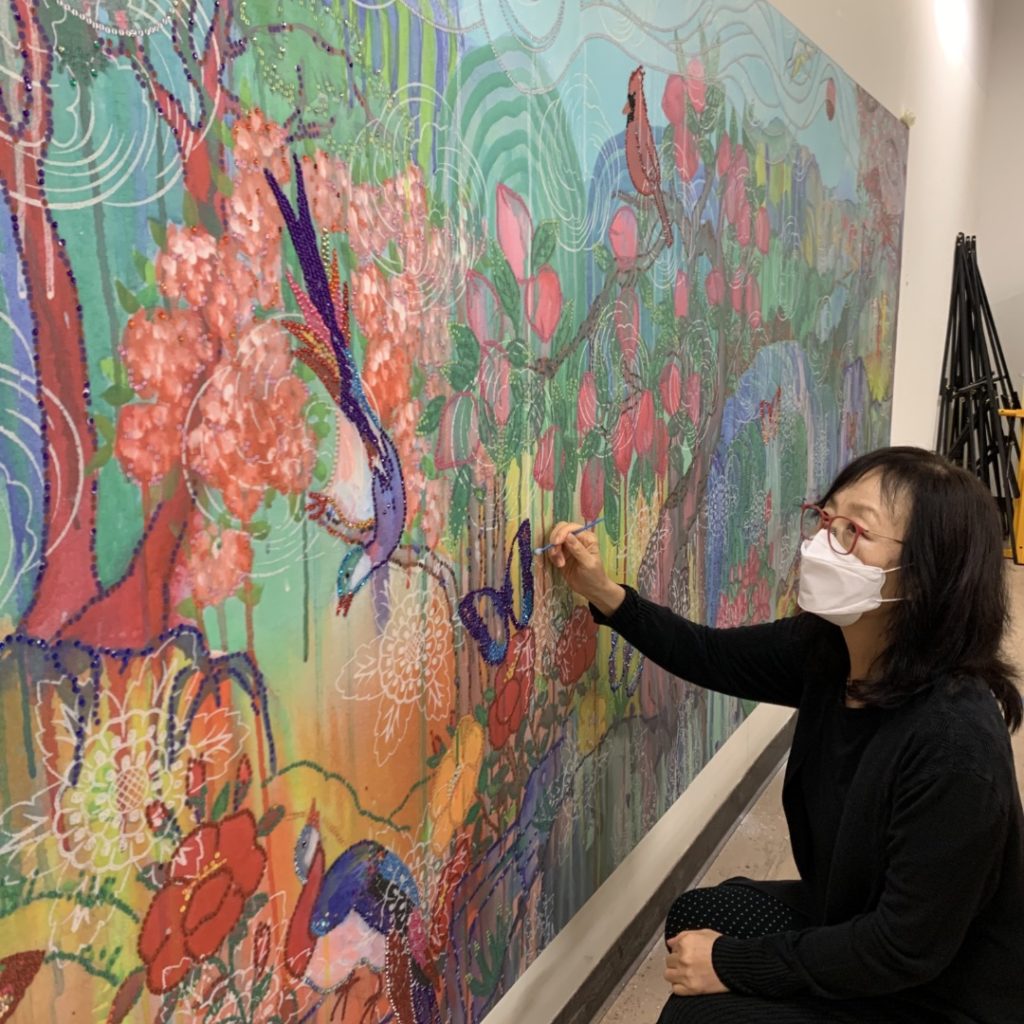
Hee Sook Kim working on
Everlasting Playground I, 2021
Passengers at the Philadelphia International Airport between September 2021 through May 2022 experienced this generous intention for healing through Kim’s installation Everlasting Playground (2021, acrylic, oil, rhinestones on canvas, 120” x 40”). This large-scale painting is another example of just how much information, influence, and inspiration Kim can synthesize into one work. The colorful mural shows a landscape with multiple layers of paint, rhinestone elements, and decorative patterns that sum up the artist’s life experiences. Immediately, viewers are attracted by the butterflies that have been a constant element in her paintings since she was an art student. The landscape references Kim’s affinity for traditional Korean paintings, and the rabbits under the tree at the top right corner are reminiscent of the animals from Hieronymus Bosch’s masterpiece, The Garden of Earthly Delights, which Kim saw during a recent trip to Europe, as well as the plants and flowers that have occupied and distracted her during the pandemic. Everlasting Playground is an emphatic expression of Kim’s lifelong development of artistic life. She has devised an open and generous process of seeing-thinking-becoming that has allowed her to overcome obstacles and confront challenges throughout her career. As travelers walk by, unbeknownst to them, they are experiencing the unfolding of a forty-year career rooted in personal growth and the hope of healing the world. The synthesis of experiences, ideas, and material in this piece becomes a visual salve that provides relief in these hectic and painful times.
The three bodies of work discussed in this exhibition give viewers delightful insight into an artist’s world-making. The world as we experience it is not necessarily the world that we would like to see, but in her art, Kim shows us how we can look at our experiences differently. She has given the world, especially the Haverford community, an enormous gift with her work. The exhibition is presented in two venues—the Cantor Fitzgerald Gallery at Haverford College, and the Williams Center Gallery at Lafayette College in Easton, Pennsylvania—to spread the message of hope and healing embedded within the work.

